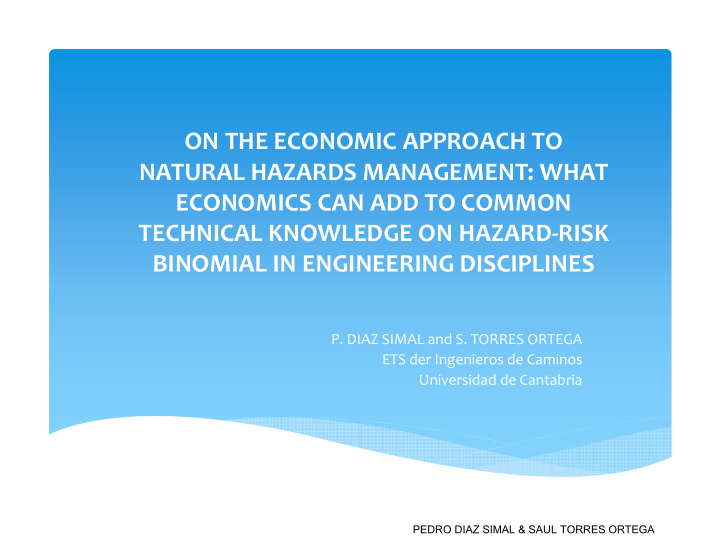



ON THE ECONOMIC APPROACH TO NATURAL HAZARDS MANAGEMENT: WHAT ECONOMICS CAN ADD TO COMMON TECHNICAL KNOWLEDGE ON HAZARD-RISK BINOMIAL IN ENGINEERING DISCIPLINES P. DIAZ SIMAL and S. TORRES ORTEGA ETS der Ingenieros de Caminos Universidad de Cantabria PEDRO DIAZ SIMAL & SAUL TORRES ORTEGA
Who we are? ∗ Economics vs. Engineering , what a strange couple , or not? ∗ Are we in fashion? ∗ Modeling previous or understanding the future? ∗ Mr. Roberts quote: ∗ Core subjects IDENTITY ∗ Threads INTERDISCIPLINARY ∗ Further reading FUTURE? PEDRO DIAZ SIMAL & SAUL TORRES ORTEGA
The problem ∗ Increasing risk awareness ∗ Need to create a conceptual framework ∗ Different contributions from diferent areas ∗ Geography ∗ Economics ∗ Environmental sciences ∗ Need to clarify concepts to share knowledge. PEDRO DIAZ SIMAL & SAUL TORRES ORTEGA
Natural risk management as emergent topic Diverse approaches Areas of Concern technical/economics Increasing degree of Diversity of variables Sustainability • • awareness Diversity of time • Increasing concern horizons • Climate Change Shortage of • resources Diversity of sources • PEDRO DIAZ SIMAL & SAUL TORRES ORTEGA
Some Theoretical reflections 1. Framework: basic elements included in the analysis. 1. Flows 2. Controls 3. Stocks 4. Attributes 2. Theories 1. Identify and set priorities among relevant elements 2. Solve specific questions 3. Fix proposals for assumptions 3. Specific models introduced to represent each case study PEDRO DIAZ SIMAL & SAUL TORRES ORTEGA
Two different frameworks DPSIR PSR FLOWS 1.- Drivers: different drivers towards Specific needs 1.- Shock will exist 2.- Pressures: demands raised to the environment 2.- Different pathways 3.- States: pollution externalities and levels of services reached 3.-Final consequences on each 4.- Impacts: loss of quality receptor. STOCKS 5.- Responses: recombination of the system CONTROLS 1.- General system of feedbacks 1.-Physical process 2.- Reassignment of resources and functions 2.-Probabilistic impact - response ATTRIBUTES 1.- Heterogeneity Resilience Vulnerability: 1.- Hazard – Exposure 2.-Decomposability 1.- Homeostasis 2.- Susceptibility 3.- Predictability 2.- Omnivory 3.- Vulnerability 4.- Extent in space and time 3.- High Flux 4.- Resilience 5.- Resilience-vulnerability 4.- Flatness 5.- Adaptive capacity 6.-Productivity 5.- Buffering 6.- Redundancy PEDRO DIAZ SIMAL & SAUL TORRES ORTEGA
Six theoretical approaches Evolutionary Institutional Entitlement Ecological Risk Natural economics economics theories economics Management hazard and Catastrophes Holling (1973) Sen (1976) analysis Basics 4 steps Social The economic The role of Risk 1.- Risk hazard assumptions Evolutionary Framework, and social nature as management probability paths Governance conditions provider of decisions quantification The adaptive Agents make the services as (adaptation 2.-Expected process that perception difference part of the mitigation, damage rules human concern and available assumed and natural awareness capital damage…) evolution as subject of the analysis PEDRO DIAZ SIMAL & SAUL TORRES ORTEGA
Theories for vulnerability analysis Evolutionary economics Institutional Entitlement Ecological Risk Natural hazard and economics theories economics Management Catastrophes analysis Sources of 1. Evolutionary paths 1.- Weakness of the 1.- Poverty 1. Anthropic 1.- Risk 1.- Risk hazard vulnerability 2.- Long Term States decision framework 2.- Ability to choose pressures. management probability 2.- Perception of the 2.-Carrying Capacity decisions quantification. problems and risk (adaptation 2.-Expected damage 3.- Quality of the mitigation, governance structure assumed damage…) Scale and temporal 1.- Long Term scale 1.- High scale resolution to identify vulnerable 1.- High scale 1.-Long term periods for capturing trends path of the analysis 2.- Social micro-scale areas. resolution to in natural events. (Incentives) 2.- Low scale indicators to include aggregate identify ecosystem 2.-High space resolution to capture spatial characteristics of a society units differences. 3.- Long term temporal scale. Available Qualitative information 1.- Aggregate economic data, 1.- Biodiversity 1.- Physical data on the present functions information on evolutionary and 2.- Distributive equity, 2.-Resilience 2.- Previsions on path evolution of climate adaptive capacity. 3.- Governance and transparence, 3.- Evolutionary parameters 4.- Quality of social and human capital 4.- Primary production Capacity to Projected trends 1.- GDP 1.- Sen´s Poverty 1.- National Expected damage Level of risk produce a 2.- Wealth Index Accounts ($) (probability) synthetic indicator. Distribution. environmentally 3.- Governance adjusted indicators 2.- Happiness 4.- HDI indexes PEDRO DIAZ SIMAL & SAUL TORRES ORTEGA
As a final reflection ∗ Different theoretical approaches ∗ Different conceptual framework ∗ Ambiguity and conceptual missunderstanding ∗ Concepts still in process. PEDRO DIAZ SIMAL & SAUL TORRES ORTEGA
Recommend
More recommend